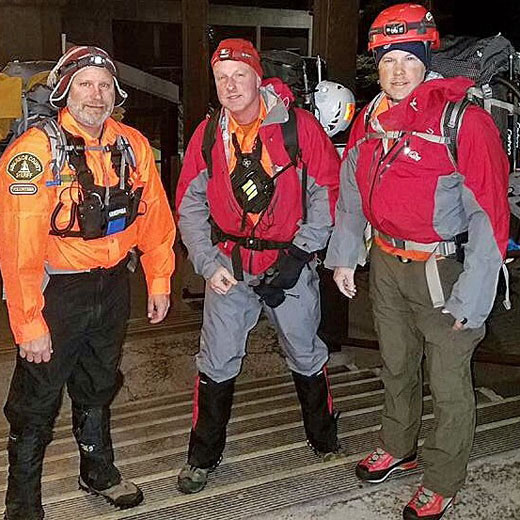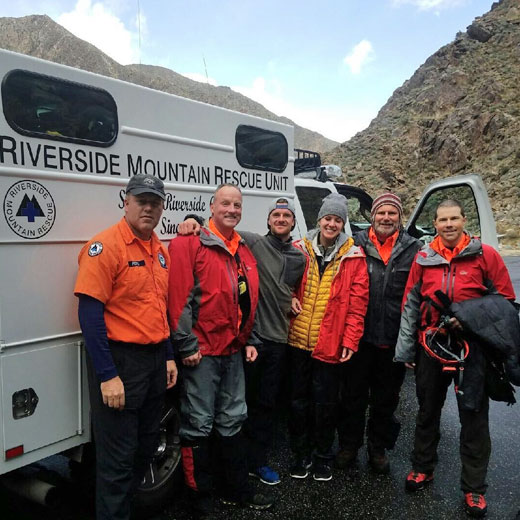Lost Couple Super Bowl Storm
|
February 5, 2017 |
Written by Wayne Smith and Kevin Kearn
On the morning of 5 February, 2017, Super Bowl Sunday, visiting Canadians, Ben Lindemulder and his wife Leanne Monsma, rode the Palm Springs tram to 8,500’ and decided to hike to the summit of San Jacinto Peak (10,800’). Although they were experienced hikers, they had only sneakers and the minimal running clothes they had travelled with, and carried only a small day pack with a little bit of water. The couple were exceptionally fit and had done several 14,000’ peaks before. Buoyed by confidence in their fitness and experience, along with the higher daytime temperatures that had softened the icy snow to compensate for their footgear, them managed to make it to the summit. However, they got disoriented and missed the tram trail turn off trying to come down - as so many do.
The couple had actually wondered off the south side of the mountain when they decided that they were lost and needed assistance. They Googled the State Parks Ranger's phone number and called them directly for help. Park Rangers attempted a rescue, however they determined that the terrain and weather were now too severe. Colder temperatures had made conditions icy as a Pacific storm was approaching; they turned back and contacted RSO to alert Riverside Mountain Rescue Unit.
An alert went out at about 8:00 pm - just as the New England Patriots tied up the Super Bowl. RMRU members left the most historic game in history not to waste a minute more with the big storm fast approaching. By 10pm, four team members had assembled and were getting ready to head up the tram. Deputy Todd Garvin from Riverside Sheriff's Office passed information to the team which included the subjects’ description and a cellphone “ping” – a coordinate obtained from the cellphone company through triangulation of cell tower signals. The ping put the subjects on the Tram side (north) side of the mountain.
When RMRU team member, Kevin Kearn, learned that they may still have cell phone service, he attempted to contact the subjects and managed to get through to Leanne. Kevin reassured her, told them we would be some hours but to get out of the wind and to stay put. He told them to keep moving to stay warm and not lay down, and to not use their cellphone to conserve the battery. We would find them. He talked her through using her iPhone “Compass App” to obtain her longitude and latitude. Her GPS position showed that she and her husband were over a mile away from the cell ping that had been driving mission planning to this point. More importantly, we realized that this new GPS position was on the other (south) side of the mountain.
At the top of the tram, Dana Potts established the initial command post. We plotted all points on the maps and decided that the field rescue team, consisting of Kevin, Cameron and I, would first clear the cellphone ping area on the south side at 10,000 feet, then cross over the mountain at 10,600’ and descend to 10,000 on the north side to clear Leanne’s new GPS reported position in in vicinity of the Little Round Valley area. Kevin and Dana made tentative plans that anticipated loss of communications when we went over the ridge – and with the storm hitting soon, made a contingency plan to not attempt to bring the subjects up over the mountain and have them attempt to descend the icy north slopes. We would descend the Marion Mt trail. Kevin, Cameron, and I cross-levelled equipment which also included two pairs of snow shoes for the subjects. We headed off into the darkness with a renewed sense of urgency as chilly winds were already registering gusts over 45mph at the Tram.

Team Members (Wayne, Kevin, and Cameron) ready to Hike
Photo by Dana Potts.
At 2300 hours, we were on course to hit the cell ping triangulation point which was close to the summit of San Jacinto peak. The weather conditions were gusty with light snow though the larger storm was forecast to hit at about dawn. The team affixed their crampons and with ice axes in hand and helmets on, set out for the first point. Several miles and nearly two thousand feet of elevation gain later, we searched the first point and found no one. Our three headlamps barely glowed in blowing snow in the cloud layer now and winds increased as we crested the ridge. Confidence was high that the subjects phone GPS coordinates were accurate so the team wasted no time in continuing to that point as fast as we could. With the cold, windy current conditions and the impending storm, the team pushed hard to find the subjects before they succumbed to the extreme conditions.
At 04:15 AM, just before dawn, we made audible contact with the subjects. The coordinates the subjects had given us, led us directly to them. They were freezing cold but elated and in surprisingly good condition. The couple had covered the snow with pine boughs to protect their uninsulated running shoes from the cold snow covered ground. They had also maintained body heat by walking in place and doing calisthenics.
The team gave them warm clothing, waterproof pants and jackets, fed them sugary foods, and Cameron gave them hot liquids. Within minutes of our arrival, a steady freezing rain began to fall as the main storm hit – coating trees, our packs, gear, and everything with ice. With a choice of either hunkering down or attempting to descend, we decide to descend. Our subjects were motivated and recharged after getting fed and warmed up. We began the long process of hiking them out as the full weight of the storm hit at dawn. We gave the subjects snow shoes and both proved to be very capable hikers/snow shoe hikers. It was still slow going as Kevin and Cameron navigated our 6-hour trek down the mountain to the Marion Mountain campground where Dana would pick us up. Freezing rain eventually turned to cold rain for the remainder of the descent down.
At noon, the group finally reached the campground and were greeted by Dana and an RSO deputy. When asked why they set out into the snow-covered mountains with only jogging gear, they replied that they had expected to be out only a couple of hours - a mistake which nearly cost them their lives. Everyone was in good spirits though now soaked to the bone. Very grateful, and with only minor hypothermia and tired muscles, the subjects were driven back to the base of the tram where their adventure began some 28 hours prior.

Tramway Base (L-R) (Dana, Kevin, Subjects center, Wayne, and Cameron)
Photo by RSO Sheriff.
RMRU’s rescue team, having just come off a mission the previous morning, covered 14.5 miles in crampons and snow shoes in a storm to accomplish this mission.
RMRU Members Involved: Cameron Dickinson, Kevin Kearn, Dana Potts, and Wayne Smith.